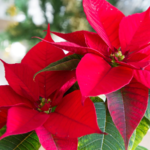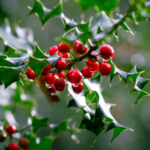 One of the most recognizable signs of the holidays is the plant Euphorbia pulcherrima, or commonly known as “poinsettia” (pictured on the left). The poinsettia derives its name from Joel Roberts Poinsett, the first United States (US) Minister to Mexico, who is credited with introducing the plant to the US in the 1820s. Contrary to a popular belief, this festive plant is not deadly. This misperception likely stems from the death of one child over a century ago; however, the accuracy of that case has been disputed due to its lack of evidence.3 Animal ingestions greater than 25 g/kg have demonstrated little or no significant clinical effect.3 Poinsettia plants contain a mild irritant, which can cause mild nausea, vomiting, and diarrhea. The milky sap from the flower may cause skin irritation.3 Poinsettias are safe to have in the home during the holidays.4 However, not all holiday plants are as benign as the poinsettia. Holly is a member of the Aquifoliaceae family. The holly (pictured on the left) we use to adorn most things around the holidays is the European holly, Ilex aquifolium (pictured on the left). Its bright green spiky leaves and red berries have become a symbol of the holidays, ranging from cards to carols. However, bright red berries can be attractive to children and are potentially toxic.5 Although 20 to 30 berries are often
One of the most recognizable signs of the holidays is the plant Euphorbia pulcherrima, or commonly known as “poinsettia” (pictured on the left). The poinsettia derives its name from Joel Roberts Poinsett, the first United States (US) Minister to Mexico, who is credited with introducing the plant to the US in the 1820s. Contrary to a popular belief, this festive plant is not deadly. This misperception likely stems from the death of one child over a century ago; however, the accuracy of that case has been disputed due to its lack of evidence.3 Animal ingestions greater than 25 g/kg have demonstrated little or no significant clinical effect.3 Poinsettia plants contain a mild irritant, which can cause mild nausea, vomiting, and diarrhea. The milky sap from the flower may cause skin irritation.3 Poinsettias are safe to have in the home during the holidays.4 However, not all holiday plants are as benign as the poinsettia. Holly is a member of the Aquifoliaceae family. The holly (pictured on the left) we use to adorn most things around the holidays is the European holly, Ilex aquifolium (pictured on the left). Its bright green spiky leaves and red berries have become a symbol of the holidays, ranging from cards to carols. However, bright red berries can be attractive to children and are potentially toxic.5 Although 20 to 30 berries are often  referred to as the “lethal dose”, no specific reference or cases could be found to verify this number.5 It likely that ingestion of a few berries is enough to cause nausea, vomiting, and diarrhea.5 Due to this risk, if fresh holly is used to decorate, please remove the berries so that children or pets do not mistakenly ingest them. It’s okay to deck the halls with boughs of holly this year, just be sure not to eat the berries.
referred to as the “lethal dose”, no specific reference or cases could be found to verify this number.5 It likely that ingestion of a few berries is enough to cause nausea, vomiting, and diarrhea.5 Due to this risk, if fresh holly is used to decorate, please remove the berries so that children or pets do not mistakenly ingest them. It’s okay to deck the halls with boughs of holly this year, just be sure not to eat the berries.


No comments yet. You should be kind and add one!
The comments are closed.